The Economics and Statistics Division maintains archives of previous publications for accountability purposes, but makes no updates to keep these documents current with the latest data revisions from Statistics Canada. As a result, information in older documents may not be accurate. Please exercise caution when referring to older documents. For the latest information and historical data, please contact the individual listed to the right.
<--- Return to Archive
For additional information relating to this article, please contact:
August 28, 2020COMPENSATION OF EMPLOYEES Q2 2020 Nova Scotia's seasonally adjusted employee compensation (wages+salaries+employer social contributions) decreased 6.7 per cent in the second quarter of 2020 to $5.92 billion. Compared to the second quarter of 2019, compensation was down 3.9 per cent.
The wages and salaries portion of employee compensation was down 6.6 per cent to $5.10 billion in the second quarter. Compared to the Q2 2019, wages and salaries were down 4.0 per cent. On a year-over-year basis, Nova Scotia's wages and salaries declined in every month of Q2 2020. Some recovery in wages and salaries in June (+2.9 per cent on the previous month) improved year-over-year growth from -5.7 per cent in May to -2.6 per cent in June.
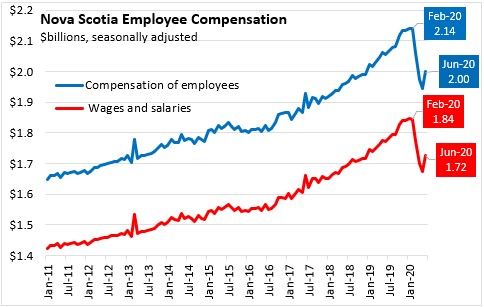
As of June, employee compensation has declined 6.5 per cent compared to February 2020, with wages and salaries down 6.4 per cent and employer’s social contributions down 6.9 per cent. Compared to June 2019, employee compensation declined 2.6 per cent, with wages and salaries down 2.6 per cent and employer’s social contributions down 2.5 per cent compared to a year ago.

In the second quarter Canada’s employee compensation was down 8.9 per cent compared to quarter one, with all provinces experiencing declines. Alberta (-11.3%), Newfoundland and Labrador (-10.3%) and Quebec (-9.0%) report the largest negative impacts. Prince Edward Island (-3.9%), New Brunswick (-5.5%) and Saskatchewan (-6.1%) reported the smallest percentage declines.
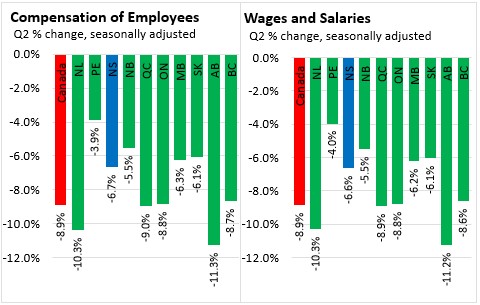
Measures to contain COVID-19 were implemented in all provinces in March 2020 and all provinces reported declines in employee compensation. Compared with February, employee compensation was down 4.6 per cent nationally, with the largest percentage decline in Quebec (-5.9%) and the smallest in Newfoundland and Labrador (-2.2%) and Prince Edward Island (-1.9%).
A full month of containment measures brought further declines in compensation in April for all provinces, with the national total down 6.0 per cent. Newfoundland and Labrador (-9.0%), Alberta (-7.2%) and Quebec (-7.0%) reported the largest percentage declines in April, while Manitoba (-1.1%) report the smallest impact.
May saw mixed signs of recovery for employee compensation, with Prince Edward Island (+2.6%), Quebec (+0.6%) and Saskatchewan (+0.3%) reporting positive monthly growth. Declines narrowed for other provinces, with the largest percentage decrease reported for Alberta (-2.9%). Nationally, compensation declined 1.2 per cent in May.
All provinces saw month-over-month growth in compensation for June, with the national total increasing 2.8 per cent. Quebec (+5.1%), New Brunswick (+4.4%) and Prince Edward Island (+3.3%) reported the largest percentage increases for June.
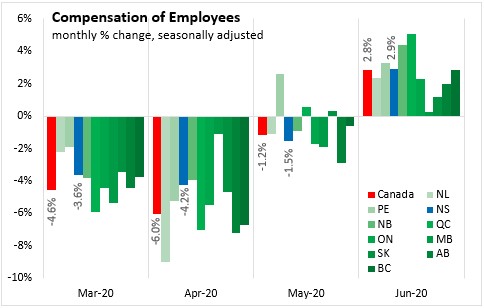
Comparing the seasonally unadjusted data for Q2 2020 with the same period in 2019, total wages and salaries decreased 4.3 per cent in Nova Scotia. The largest percentage declines were reported for agriculture, forestry and fishing (-18.2%), Construction (-15%), and trade (-13.8%). Utilities (+17.8%) followed by information and cultural industries (+12.5%) and finance and real estate (+4.6%) had the strongest growth compared to Q2 2019.
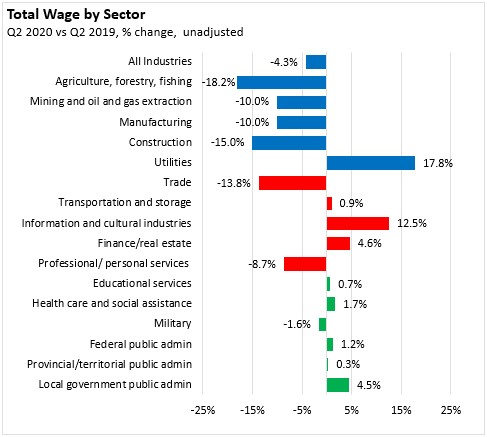
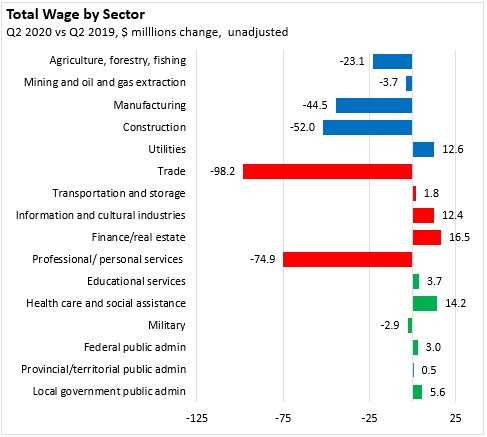

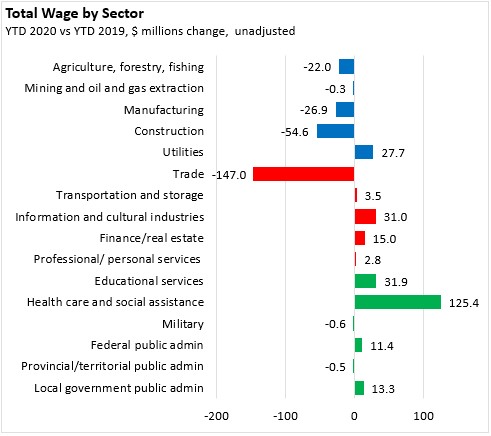
Note: comparison of wages and salaries by sector rely on data that are neither seasonally adjusted nor adjusted to reflect differences in pay periods from one year to the next.
During the COVID-19 pandemic, comparisons of year-to-date averages and sums do not show Nova Scotia’s rapidly-changing economic situation. The DailyStats will focus on year-over-year comparisons, comparing one month with the same month in the prior year. Where possible the DailyStats will make comparisons of seasonally adjusted data from the pre-COVID-19 period (January and February 2020) with the period during which COVID-19 measures were in place from March 2020 onwards.
Statistics Canada. Table 36-10-0205-01 Wages, salaries and employers' social contributions (x 1,000)
<--- Return to Archive